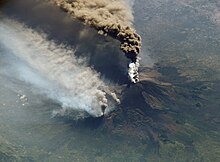Flank eruption

A flank eruption is a volcanic
eruption which occurs on the flanks of a volcano, instead of at its summit. Such eruptions occur when the conduit connecting the summit to the magma chamber below is blocked, forcing the magma
to move laterally.
Overview
At some volcanoes, flank eruptions are common, and occur along clearly defined
Reunion Island,[1] and Mount Etna in Italy.[2] Flank and summit eruptions may occur at the same time.[3]
Where there are inhabited areas on the flanks of a volcano, flank eruptions may be more destructive and dangerous than summit eruptions.[4] Flank eruptions may also trigger the collapse of the volcanic edifice, causing lateral eruptions (such as the 1980 eruption of Mount St. Helens), landslides and tsunamis. Collapse-drive eruptions are among the largest and most destructive volcanic phenomena.[5]
References
- .
- .
- ^ "The 2018 rift eruption and summit collapse of Kīlauea Volcano | Science". science.sciencemag.org. Archived from the original on 2019-01-25.
- S2CID 212809291.
- PMID 29348427.
